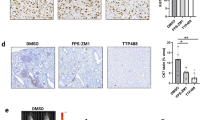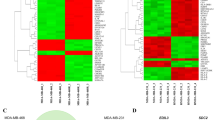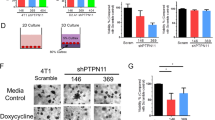Abstract
The development of resistance to chemotherapeutic drugs is a major obstacle to the successful treatment of breast cancer. Ways to block or overcome this resistance are objects of intense research. We have previously shown that cancer cells selected for resistance against chemotherapeutic drugs or isolated from metastatic tumor sites have high levels of a calcium-dependent protein crosslinking enzyme, tissue transglutaminase (TG2) but no direct link between TG2 and resistance was established. As TG2 can associate with the β members of the integrin family of proteins, we hypothesized that TG2 promotes cell survival signaling pathways by activating integrins on the surface of these cells. To test this hypothesis, we studied the expression of TG2 and its interaction with various integrins in drug-resistant MCF-7 breast cancer cells. TG2 closely associated with β1 and β5 integrins on the surface of drug-resistant MCF-7 (MCF-7/Dox and MCF-7/RT) cells. The incubation of TG2-expressing drug-resistant MCF-7 cells on fibronectin (Fn)-coated surfaces strongly activated focal adhesion kinase, an event that leads to the activation of several downstream signaling pathways and, in turn, can confer apoptosis-resistant phenotype to cancer cells. The role of TG2 in Fn-mediated cell attachment, cell growth, and cell survival functions was further analysed by small interfering RNA (siRNA) approach. Inhibition of TG2 by siRNA-inhibited Fn-mediated cell attachment and cell survival functions in drug-resistant MCF-7 cells. We conclude that the expression of TG2 in breast cancer cells contributes to the development of the drug-resistance phenotype by promoting interaction between integrins and Fn.
This is a preview of subscription content, access via your institution
Access options
Subscribe to this journal
Receive 50 print issues and online access
$259.00 per year
only $5.18 per issue
Buy this article
- Purchase on Springer Link
- Instant access to full article PDF
Prices may be subject to local taxes which are calculated during checkout








Similar content being viewed by others
References
Akimov S, Belkin A . (2001). J Cell Sci 114: 2989–3000.
Akimov SA, Krylov D, Fleishman L, Belkin AM . (2000). J Cell Biol 148: 825–838.
Antonyak M, Singh U, Lee D, Boehm J, Combs C, Zgola M et al. (2001). J Biol Chem 279: 8715–8722.
Antonyak MA, Miller AM, Jansen JM, Boehm JE, Balkman CE, Wakshlag JJ et al. (2004). J Biol Chem 279: 41461–41467.
Aoudjit F, Vuori K . (2001). Oncogene 20: 4995–5004.
Autuori F, Farrace M, Oliverio S, Piredda L, Piacentini M . (1998). Adv Biochem Eng Biotechnol 62: 129–136.
Boehm JE, Singh U, Combs C, Antonyak MA, Cerione RA . (2002). J Biol Chem 23: 20127–20130.
Cary LA, Chang JF, Guan JL . (1996). J Cell Sci 109: 1787–1794.
Chen J, Agarwal N, Mehta K . (2002). Br Cancer Res Treat 71: 237–247.
Chen J, Mehta K . (1999). Int J Biochem Cell Biol 31: 817–836.
Chen J, Kanopleva M, Multani A, Pathak S, Mehta K . (2004). J Cell Physiol 200: 223–234.
Cordes N, Blaese M, Plasswilm L, Rodemann H, Van Beuningen D . (2003). Int J Radiat Biol 79: 709–720.
Damiano JS, Cress AE, Hazlehurst LA, Shtil AA, Dalton WS . (1999). Blood 93: 1658–1667.
Damiano JS, Hazlehurst LA, Dalton WS . (2001). Leukemia 15: 1232–1239.
Danen EH, Yamada KM . (2001). J Cell Physiol 189: 1–13.
Davies PJ, Piacentini M . (1994). Mol Cell Biol 14: 6584–6596.
de la Fuente MT, Casanova B, Moyano JV, Garcia-Gila M, Sanz L, Garcia-Marco J et al. (2002). J Leukoc Biol 71: 495–502.
De Laurenzi V, Melino G . (2001). Mol Cell Biol 21: 148–155.
Devarajan E, Multani A, Pathak S, Sahin A, Mehta K . (2002). Int J Oncol 20: 913–920.
Fesus L, Davies P, Piacentini M . (1991). Eur J Cell Biol 56: 170–177.
Guan JL . (1997). Int J Biochem Cell Biol 29: 1085–1096.
Hang J, Zemskov EA, Lorand L, Belkin AM . (2005). J Biol Chem 280: 23675–23683.
Ilic D, Furuta Y, Kanazawa S, Takeda N, Sobue K, Nakatsuji N et al. (1995). Nature 377: 539–544.
Jeong JM, Murthy SNP, Radek JT, Lorand L . (1995). J Biol Chem 270: 5654–5658.
Korah R, Boots M, Wieder R . (2004). Cancer Res 64: 4514–4522.
Longtin R . (2004). J Natl Cancer Inst 96: 6–8.
Lorand L, Graham R . (2003). Nat Mol Cell Biol 4: 140–156.
Mangala LS, Mehta K . (2005). Tissue transglutaminase in cancer. In: Mehta K and Eckert R (eds), Progress in Experimental Tumor Research. AG Karger Press: Basel, pp 125–138.
Mauro L, Sisci D, Bartucci M, Salerno M, Kim J, Tam T . (1999). Exp Cell Res 252: 439–448.
Mehta K, Devarajan E, Chen J, Multani A, Pathak P . (2002). J Natl Cancer Inst 94: 1652–1654.
Mehta K, Fok J, Miller FR, Koul K, Sahin AA . (2004). Clin Cancer Res 10: 8068–8076.
Mehta K . (1994). Int J Cancer 58: 400–406.
Milakovic T, Tuchoiski J, McCoy E, Johnson G . (2004). J Biol Chem 279: 8715–8722.
Nanda M, Ismaa SE, Owen WA, Husain A, Mackay F, Graham RM . (2001). J Biol Chem 276: 20673–20678.
Nista A, Leonetti C, Bernardini G, Mattioni M, Santoni A . (1997). Int J Cancer 72: 133–141.
Oliverio S, Amendola A, Di Sano F, Farrace MG, Fesus L, Nemes Z et al. (1997). Mol Cell Biol 17: 6040–6048.
Parise L, Lee J, Juliano R . (2000). Semin Cancer Biol 10: 407–414.
Price LS, Leng J, Schwartz MA, Bokoch GM . (1998). Mol Cell Biol 9: 1863–1871.
Roovers K, Davey G, Zhu X, Bottazzi ME, Assoian RK . (1999). Mol Biol Cell 10: 3197–3204.
Schlaepfer DD, Hauck CR, Sieg DJ . (1999). Prog Biophys Mol Biol 71: 435–478.
Schlaepfer DD, Mitra SK, Ilic D . (2004). Biochim Biophys Acta 1692: 77–102.
Sonoda Y, Matsumoto Y, Funakoshi M, Yamamoto D, Hanks SK, Kasahara T . (2000). J Biol Chem 275: 16309–16315.
Xu LH, Yang X, Craven RJ, Cance WJ . (1998). Cell Growth Differ 9: 999–1005.
Zhang Z, Vuori K, Read JC, Ruoslahti E . (1995). Proc Natl Acad Sci USA 92: 6161–6165.
Acknowledgements
We thank Ms Jansina Y Fok for technical help and Dr Walter Pagel for the editorial help.
Author information
Authors and Affiliations
Corresponding author
Rights and permissions
About this article
Cite this article
Herman, J., Mangala, L. & Mehta, K. Implications of increased tissue transglutaminase (TG2) expression in drug-resistant breast cancer (MCF-7) cells. Oncogene 25, 3049–3058 (2006). https://doi.org/10.1038/sj.onc.1209324
Received:
Revised:
Accepted:
Published:
Issue Date:
DOI: https://doi.org/10.1038/sj.onc.1209324
Keywords
This article is cited by
-
TG2 as a novel breast cancer prognostic marker promotes cell proliferation and glycolysis by activating the MEK/ERK/LDH pathway
BMC Cancer (2022)
-
Mechanistic role of transglutaminase-2 in focal adhesions
Scientific Reports (2018)
-
Transamidase site-targeted agents alter the conformation of the transglutaminase cancer stem cell survival protein to reduce GTP binding activity and cancer stem cell survival
Oncogene (2017)
-
Tissue transglutaminase (TG2) enables survival of human malignant pleural mesothelioma cells in hypoxia
Cell Death & Disease (2017)
-
Tissue transglutaminase (TG2) is involved in the resistance of cancer cells to the histone deacetylase (HDAC) inhibitor vorinostat
Amino Acids (2017)



